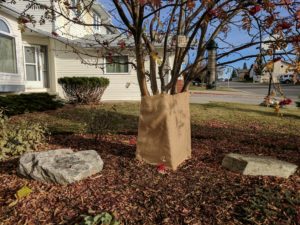Young trees especially those with thin bark trees are most susceptible, particularly newly planted trees. Older trees of the same species develop thicker bark and established root systems making them less susceptible.

Sunscald damage occurs in winter and early spring and affects the south west side of thin bark trees. Many trees start with a thin bark that becomes thicker and rougher with time as the tree ages. A few trees like Mayday, Cherry and Mountain ash do not get thicker bark with age and remain very prone to damage through their life. The direct sun or sunlight reflected by snow heats tree bark during the day. The tissues becomes active and break dormancy. With much colder night-time temperatures, the active tissues that were coaxed out of dormancy are killed. The bark area involved shows an elongated canker that appears discolored and sunken. Cracking and peeling of the bark may follow. The damage may not show until the following growth season when new growth occurs. This may also create a wound were insects and disease may enter the tree.

In Calgary these tree species are most often affected:
- Mountain Ash
- Mayday
- Amur Cherry
- Chokecherry

Control Measures
- Wrap the bark of new/young trees with commercial tree wrap or burlap. Be sure to remove the material in the spring. If left in place, it attracts insects and diseases. Over time it can also girdle the trunk.
- Be careful when pruning. Avoid heavy pruning of trees that will expose branches,limbs or trunk areas that have been shaded in the past from direct sunlight.
- Use temporary structures such as decorative fencing to provide shade for the tree or use tall perrenials or shrubs on the southwest side of the trees to provide protection.
- DO NOT Paint tree trunks with white paint. Old recommendations may have included this but is less effective than other controls mentioned above and will cause other issues for the tree.


